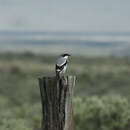mk
имиња во трошки


The Loggerhead Shrike (Lanius ludovicianus), the only member of the Family Laniidae, is a predatory songbird of North America. It is slightly smaller than a robin, weighing 1.2-1.8 g at birth, to 35-50 g at maturity. There are 11 subspecies in North America, with 3 located in Canada. Loggerhead Shrikes in northern regions migrate south (Hobson & Wassenaar 2001), while birds residing in the lower United States and Mexico remain in place for the winter. Two subspecies, L.l. mearnsi and L.l. anthonyi are island birds residing on the Channel Islands of California, with the former listed as endangered and the latter listed as special concern (ECOS 2013). As a species, with a global breeding population of 5.8 million (PIF 2012), Lanius ludovicianus is identified of Least Concern by the IUCN, although their populations decreased 3.2% per year from 1966-2010 (CLO 2015).
The subspecies of Loggerhead Shrike are similar in appearance, with a notable black mask across the beak and eyes.These birds show no sexual dimorphism. They are gray bodied with white underbellies, and have black wings and tail that contain white patches. Their wingspan is 28-32 cm and length of 20-23 cm. Their larger heads give them their common name “loggerhead” which translates to “blockhead”, but is their toothed beaks and keen eyesight that give them their predatory identity. Unlike most predatory birds, however, they do not have talons.
Loggerhead Shrikes are found in the open areas of grassland and low shrubbery of Lower Canada, U.S., and Mexico. They spend most of their time hunting, both for food purposes and mating. They perch where they can observe their prey, but also where there they can impale their prey, such as thorny shrubs and barbed wire, as their claws are not strong enough to hold the victim. Stock piling their kill is often used to attract a mate. They feed on insects, amphibians, reptiles, rodents, and small birds.
In addition to small stockpiles of food, Loggerhead Shrikes also perform short flights of display to attract a partner. Together, male and female build a nest out of twigs, bark, and dried grasses in shrubs or trees in open areas. Their clutch of 4-8 eggs, “grayish white to pale bluff, with spots of brown and gray often concentrated at large end” (AFG 2001) is incubated by the female while the male supplies her with food. Chicks hatch naked and blind, taking take flight between 17-21 days, and remain with parents for an additional 3-4 week. The longest recorded lifespan for a Loggerhead Shrike was 12.5 years (Klimkiewicz, et al. 1983).
The Loggerhead Shrike has long been considered an indicator species, and is often found near areas of agriculture (Yosef 1994). It is unknown why their numbers are decreasing, although habitat loss, predation, and pesticides are commonly addressed (Boal et al. 2003). In 2014 they were listed as a Common Bird in Steep Decline (Parmley 2015). Of research interest, island subsubspecies. L.l. mearnsi located on San Clemente Island is endangered according to the U.S. Endangered Species Act and IUCN. Although Loggerhead Shrikes high reproductive rate makes them more likely to rebound, this subspecies population is threatened by one of its natural predators, the island fox (Urocyon littoralis), which is also an endangered species (Roemer & Wayne 2003).
A medium-sized (9 inches) shrike, the Loggerhead Shrike is most easily identified by its gray body, dark wings, and large hooked bill. Other field marks include a black tail with white edges, a black eye-stripe, and white “wrists” visible on the underside of the wings. This species may be separated from the Northern Shrike (Lanius excubitor) by the latter species’ faintly barred breast and from the Northern Mockingbird (Mimus polyglottos) by that species’ large white wing patches. Male and female Loggerhead Shrikes are similar to one another in all seasons. The Loggerhead Shrike breeds across the southern and southwestern United States as well as the Great Plains and locally in the Great Lakes region. Breeding populations also exist at higher elevations in northern and central Mexico. Northern Loggerhead Shrike populations are migratory, moving south in winter as far as Mexico. Loggerhead Shrikes inhabit a variety of open habitats, including grasslands, agricultural fields, and deserts. This species utilizes similar habitats in winter as in summer, especially those populations which are non-migratory. Loggerhead Shrikes eat a variety of small animals, including insects, small mammals, and birds. Loggerhead Shrikes are most easily observed perching in prominent areas, such as on bare branches, while watching for prey. This species impales its prey on thorns or barbed wire, and birdwatchers who stumble across one of these “larders” would likely find a Loggerhead Shrike nearby. This species is primarily active during the day.